Dairy Products: Types and Nutritional Value

This post is also available in:
This post is also available in:
![]() हिन्दी (Hindi)
हिन्दी (Hindi) ![]() Português (Portuguese (Brazil))
Português (Portuguese (Brazil))
What is the evolution of dairy products?
Dairing– Civilization to industry
Milk was essentially a toxin to humans until 7500 years ago because – unlike infants – they could not synthesize an enzyme called lactase which breakdowns Lactose (the main sugar in milk) into simple sugars like glucose and galactose. The history of dairy farming started way before that. It is estimated that dairy farming as an agricultural practice originated in the Middle East around 11000 years ago when Neolithic culture developed there. This is the start of agriculture and domestication of dairy animals.
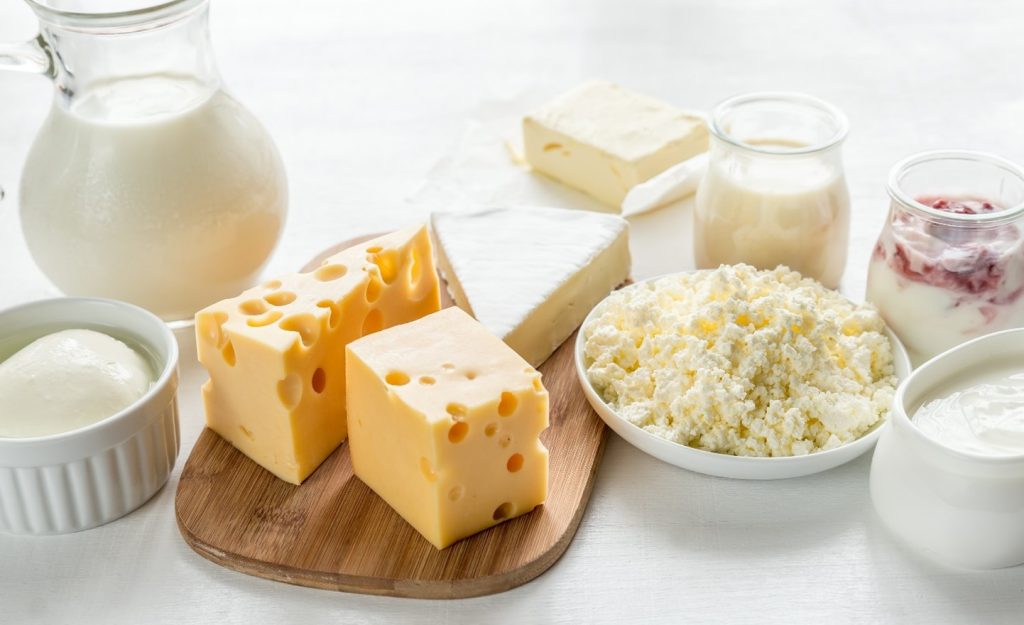
This farming culture spread from the Middle East to Greece, the Balkans, and Central Europe. Researchers claim that Lactase Persistence (the ability to drink milk in adulthood) first emerged in Central Europe. Even now, only 35% percent of the global population has the ability to digest lactose naturally in their gut.
Cheese and Yoghurt were one of the oldest dairy products produced by humans. It was produced or evolved in human civilization because of humans’ lactose intolerance before this 7500 years. Cattle herders learned how to reduce lactose in dairy products in order to tolerable levels by fermenting milk to make cheese or yogurt. Thousand years later, a genetic mutation spread through Europe, allowing people to produce lactase and drink milk. This adaptation opened up a rich new source of nutrition that could have sustained communities when harvests failed.
Growing Into a Billion Dollar Industry
The history of the dairy industry is relatively recent compared to traditional dairying and dairy products in human civilization. The most important unit operation in the dairy industry – pasteurization didn’t come into practice until the late 1800s. The first commercial milk pasteurizers were produced in 1882. It was first adopted in Germany and Denmark and later expanded to Europe, America, and other countries. Subsequently, in the upcoming decades, pasteurization became a legal mandate.

In the meantime, the discoveries of mechanical equipment like Cream Separators, Homogenizers, and Pneumatic Valves, along with the rise of mechanical refrigeration and the development of instrumentation and process control, allowed the dairy industry to grow exponentially whole over the world. These advancements also affected the location and size of the local dairies as farmers, producers, and distributors began to shift to larger, more centralized processing operations. Associated dairying or co-operatives began to become common to allow the smallest farmers or producers to continue to sell and trade.
The trade and transport of butter and cheeses had been established in Europe since the Middle Ages, as river trade moved products from country to city and city to city. However, these same advancements that improved fluid milk around the turn of the 20th century also improved the longevity and trade of other milk products.
Which is the composition of milk?
The majority of milk is water. One of the reasons that consumers choose different types of milk is their different nutritional values. For example, some kinds of milk are known for their cholesterol-lowering action, better nutrient bioavailability, potential therapeutic properties (used in gastrointestinal disorders), and the absence of allergies many consumers face. Milk fat is also a source of butyric acid, a potent inhibitor of cancer cell proliferation. Milk produced from cows or buffalo contains almost 87% water. The remaining 13% of total solids give nutritional and economic importance to milk. These are Fat, Protein, Lactose (Milk sugar) and minerals. So, milk is majorly priced based on its fat and solids content. Therefore, Fat % and SNF % (Solid, not Fat) are analyzed at the collection points and dairies to determine the prices of the products. Below you can find the main components of milk for different species.

Composition of milk according to different species.
Source: (ZHANG et al., 2016)
The Dairy Product Tree
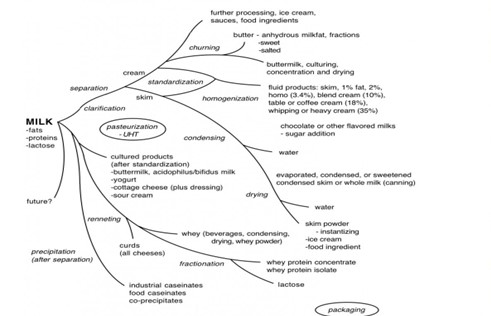
When the raw milk is received in a dairy, it is first immediately stored in silos (big cylindrical storage tanks). It should be immediately pasteurized from there to remove pathogenic and spoilage micro-organisms. During pasteurization, the milk is separated into Cream and Skim Milk using a centrifugal cream separator. All the other dairy products are produced with this skim milk and cream.
Nutritional value of different types of dairy products
Examples of different types of dairy products
Liquid Milk:
- Milk is the primary source of nutrition for mammal offspring, including humans, and has been consumed by humans for thousands of years.
- In the United States, milk is usually fortified with vitamin D, which helps the body absorb calcium and promotes bone health.
- There are many different types of milk available, including whole milk, 2% milk, 1% milk, and skim milk.
Flavored Milk:
- Chocolate milk is a popular flavored milk often consumed after exercise, as it provides a combination of protein and carbohydrates that can help replenish energy stores.
- Flavored milk can be made with natural or artificial flavors, and it is often sweetened with sugar or other sweeteners.
- In recent years, there has been a trend towards reduced-sugar or sugar-free flavored milk options.
Cream:
- Cream is the fat that rises to the top of milk when left to stand.
- There are many different types of cream, including heavy, light and half-and-half.
- Cream is often used in recipes for baked goods, sauces, and soups, as it adds richness and flavor.
Butter:
- Butter is made by churning cream until the fat separates from the liquid.
- Butter is a natural source of vitamin A, which is important for eye health, and it also contains small amounts of other vitamins and minerals.
- Butter can be used for cooking, baking, and as a spread on bread or toast.
Anhydrous Milk Fat:
- Anhydrous milk fat is made by removing the water and non-fat solids from milk fat.
- Anhydrous milk fat is often used in the production of processed foods, such as cookies, crackers, and snack foods.
- Anhydrous milk fat is also used in the production of infant formula.
Ghee:
- Ghee is a form of clarified butter that is commonly used in Indian and Middle Eastern cuisine.
- Ghee has a nutty flavor and a high smoke point, making it ideal for cooking at high temperatures.
- Ghee is also used in Ayurvedic medicine for its purported health benefits.
Fermented Dairy Products:
- Fermented dairy products, such as yogurt and kefir, contain beneficial bacteria known as probiotics, which can help promote digestive health.
- Some fermented dairy products, such as Greek yogurt, are higher in protein than traditional yogurt.
- Fermented dairy products can also be made from non-dairy sources, such as soy or coconut milk.
Cheese:
- Cheese is made by coagulating milk proteins, separating the curds from the whey, and then aging the curds.
- There are many different types of cheese, each with its unique flavor and texture.
- Cheese is a good source of calcium and protein, but it can also be high in sodium and saturated fat.
Ice cream:
- Ice cream is a frozen dairy dessert that typically contains milk, cream, sugar, and flavorings.
- The first recorded instance of ice cream being served in the United States was in 1744 in Maryland.
- Ice cream is a popular treat around the world, with many countries having unique variations and flavors.
Whey – Beverages, Powders:
- Whey protein is a complete protein, which means it contains all nine essential amino acids that the body cannot produce on its own.
- Whey protein can be found in many food products, including protein bars, shakes, and even some types of candy.
- Whey protein is a by-product of cheese production, and cheese makers used to discard it as waste until they discovered its nutritional benefits.
Evaporated Milk:
- Evaporated milk was invented in the late 1800s as a way to preserve milk without refrigeration.
- Evaporated milk is often used in recipes that call for cream or whole milk, as it is thicker and creamier than regular milk.
- Evaporated milk can also be used as a coffee creamer, as it has a similar consistency and taste to cream.
Dried Milk Products:
- Powdered milk was invented during World War II as a way to provide soldiers with a lightweight and long-lasting source of milk.
- Dried milk products can be stored at room temperature for extended periods, making them a convenient pantry staple.
- Powdered milk can also be reconstituted with water to create a low-cost alternative to fresh milk.
Industrial Caseinates:
- Casein is the main protein in milk, accounting for about 80% of its protein content.
- Caseinates are often used in processed foods such as cheese, yogurt, and ice cream, as they can help improve texture and stability.
- Industrial caseinates are also used in the production of adhesives, paper coatings, and other industrial applications.
Nutritional Value of some dairy products per 100g of product.
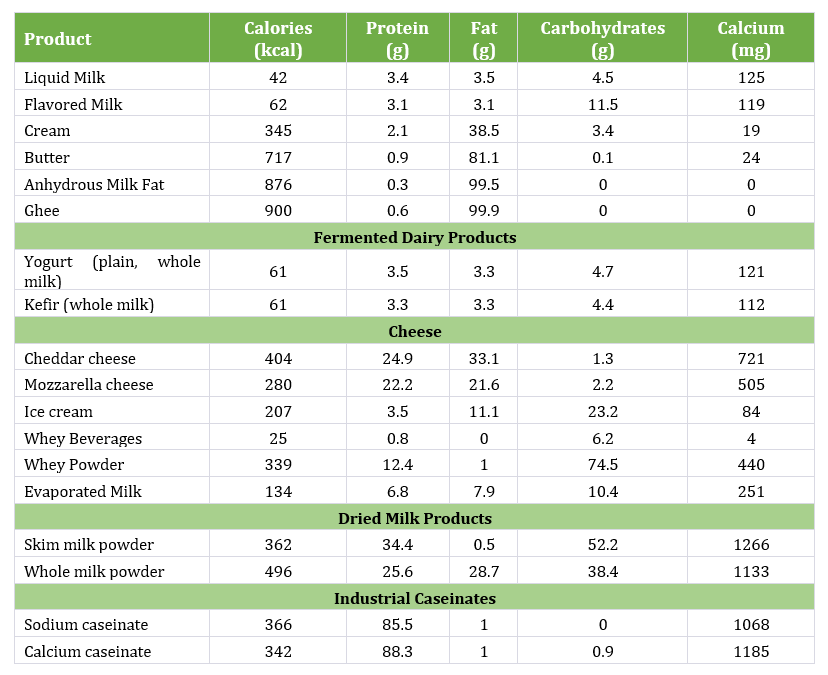
The table below contains the vitamin ranges of goat, sheep, cow, and human milk.
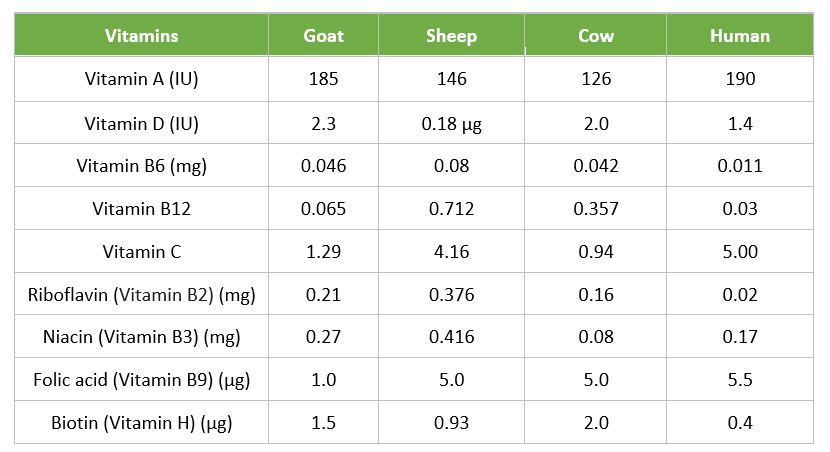
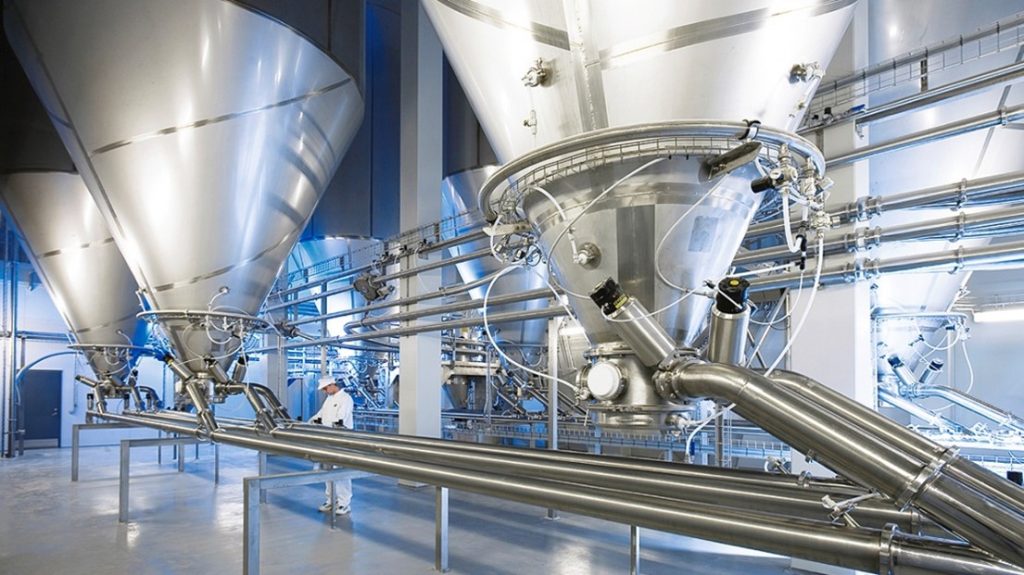
All these products have a huge history and role in human civilization. With the advancement and research in food science, dairy science, technology, and food engineering, whole production operations have become automatic and completely centralized. Complex process engineering and automation technologies have revolutionized the industry to produce standardized products without any deviation in physical, chemical, and microbiological parameters. In addition, the production volume can be scaled up to a million stock keep units daily without any intervention. With all these advancements, the dairy industry is now worth about 871 billion US dollars, serving farmers, industrialists, and other stakeholders.
References:
ZHANG, Zhihe & HOU, Rong & LAN, Jingchao & WANG, Hairui & KUROKAWA, Hiroyuki & Takatsu, Zenta & KOBAYASHI, Toyokazu & Koie, Hiroshi & KAMATA, Hiroshi & KANAYAMA, Kiichi & WATANABE, Toshi. (2016). Analysis of the breast milk of giant pandas (Ailuropoda melanoleuca) and the preparation of substitutes. Journal of Veterinary Medical Science. 78. 10.1292/jvms.15-0677.
Blaško J, Kubinec R, Górová R, Fábry I, Lorenz W and Soják L. (2010). Fatty acid composition of summer and winthe cows’ milk and butter. J Food Nutr Res. 49:169–177.
Pandya, A. J., A. J. Gokhale and Mallik, J. M. 2020. Overview of Functionality of Goat and Sheep Milk.Int.J.Curr.Microbiol.App.Sci. 9(10): 2750-2764. doi: https://doi.org/10.20546/ijcmas.2020.910.332








































































